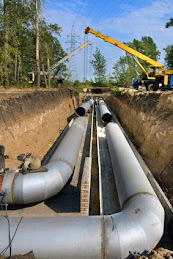Sewage, or waste waster, is produced every time someone flushes the toilet or puts something down the drain of a sink. Sewer systems are necessary to remove this waste from the general vicinity of homes and urban areas. This is necessary as sewage is unpleasant for a variety of reasons.
First and foremost, sewage smells very bad. It also is full of harmful, disease causing bacteria. Coliform bacteria is one that is naturally occurring in human feces. It would be a health hazard were the nearby land to a house or neighboring rivers or brooks were to be infected with this water.
Sewage and wastewater can also negatively affect the environment and aquatic life. Sewage is full of phosphates and nitrogen. These properties support algae growth since they are natural fertilizers. Algae can ruin water and block the sun.
Since there are solids in sewage, were the sewage to be added into local water areas, the solids could prevent the fish and other forms of wildlife from seeing and breathing at maximum capacity.
Because of these reasons, cities enact laws surrounding sewer systems and prevent the dumping of raw sewage in populated areas. In small towns were a sewer system is not practical as the population is too sparsely populated, homeowners intall their own septic tanks.
Septic tanks are buried in the backyard generally and are concrete or steel tanks holding a large amount of water. They displace the sewage by flowing it into a drain field, which consists of perforated pipes. Septic tanks are entirely passive systems in that they run solely on gravity. The gravity causes the water flowing from the house to enter the septic tank to then flow down to the drain field.
In cities and places that are more closely populated, wastewater treatment facilities are built to hold the wastewater from the sewer systems. Ideally, the sewer systems would be solely powered by gravity.
But the land usually is not set out this way, so a lift station will be part of the sewer system and moves the wastewater up and over portions of the land.
In the sewer system, pipes from individual houses or buildings run to a sewer main.
Pipes are also set up that run from the sewer main to the surface of the street and are covered by manholes so that the sewer main can be accessed when necessary. The sewer main keeps the sewage flowing into bigger and bigger pipes, until the sewage eventually gets to the wastewater treatment facility.
Upon reaching the facility, the sewage then undergoes a variety of treatments. The first treatment, the primary treatment, performs the same function as a septic tank and removes the solids, scum, bacteria and organic materials from the water.
Those materials are then burned or put into a landfill. Some facilities offer secondary and tertiary treatments, which use bacteria and chemicals to help remove the harmful components of the water even further.
Finally, chlorine is then added to the water, where it is discharged.
Zonzini Pipeline & Sewer Services is your #1 source for pipeline and sewer repair in New York! They have the background and experience to make sure all your repair needs are met! Choose Zonzini for your next pipeline or sewer repair!
Subscribe to:
Post Comments (Atom)

No comments:
Post a Comment